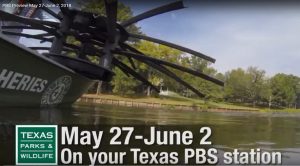TPW TV — Hands on Habitat
This is Passport to Texas
Healthy aquatic habitat means good fishing.
We are at Lake Cypress Springs to construct some artificial fish habitat structures.
Fisheries biologist Tim Bister works to enhance declining aquatic habitat.
There is not a lot of structure for fish like largemouth bass or sunfish to relate to underneath the water. And fish need habitat structure in general. Even in reservoirs that left timber standing, over time that timber in the water breaks down and the habitat for fish declines, so we’re at a point where we really need to start doing something with these reservoirs to improve fish habitat.
With supervision from Texas Parks and Wildlife, anglers Kody Corrin and Calvin Lamont, installed artificial habitat of PVC pipes in the lake.
We love fishing, but we both understand that without conservation of the lakes, we are not going to be able to do that. So it is on our part to make sure we help take care of that, take care of the resource that provides our recreation.
Structure is important, but so is food. Rick Ott manages a native aquatic plant nursery at the Texas Freshwater Fisheries Center.
The vegetation is producing food that invertebrates consume, small fish consume the invertebrates, bigger fish eat the smaller fish, and we eat the bigger fish.
Learn about artificial fish habitat next week on the Texas Parks and Wildlife TV series on PBS.
The Sport Fish Restoration program supports our series.
For Texas Parks and Wildlife, Cecilia Nasti.



 Passport to Texas is a
Passport to Texas is a  Passport to Texas is made available by:
Passport to Texas is made available by: